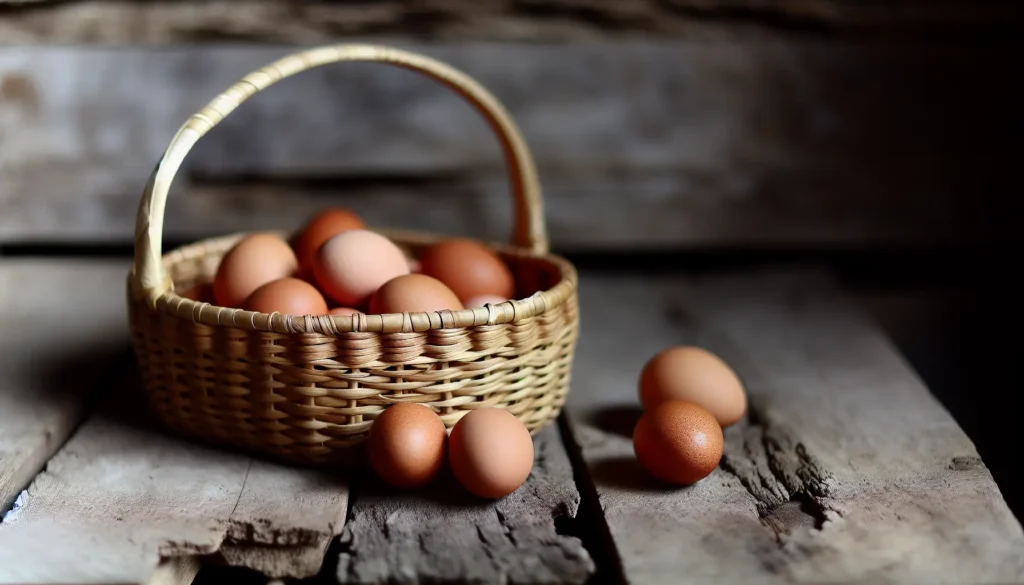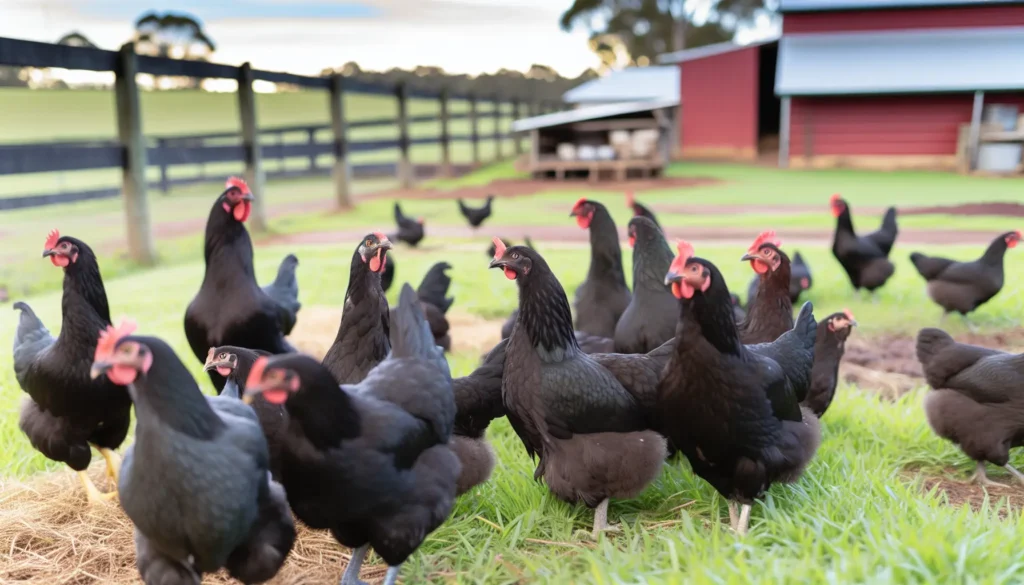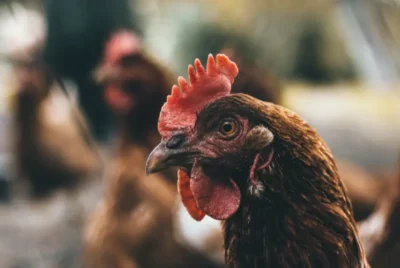Guide in Mastering the Basics of Australorp Chicken Care
Wondering if Australorp chickens are the right choice for your flock? Known for their remarkable egg production and friendly nature, Australorp chickens offer both practical and social benefits for poultry keepers. This guide outlines their essential care, behavior traits, and what makes the Australorp chicken stand out in the poultry world.
Table of Contents
- Discovering the Australorp Chicken
- The Distinctive Look of the Australorp
- Understanding Australorp Behavior
- Egg-ceptional Layers: Australorp Egg Production
- The Care and Keeping of Australorps
- Breeding and Raising Australorp Chicks
- Integrating Australorps with Other Breeds
- Where to Find Australorp Chickens
- Care Your Australorp With Chicken Raising 101
Discovering the Australorp Chicken

Australorp chickens, including both one Australorp hen and Australorp roosters, have their roots firmly planted in Australia. Their journey began with the importation of Black Orpingtons around 1890, to develop a utility breed that excelled in egg production. Among them, the Australorp rooster plays a vital role in maintaining the breed’s lineage.
The objective behind breeding Australorps in the early 1900s was to develop a dual-purpose bird that could adapt well to the Australian climate. The focus was particularly on their egg-laying capabilities, with some hens known to lay over 300 eggs in 365 days. Orpington and Rhode Island Reds were chosen for their friendly and low-aggression traits, which made them perfect for a family setting and a great addition to a mixed flock.
The Distinctive Look of the Australorp

Australorp chickens, specifically the black australorp variety, have the following physical characteristics:
- Close-fitting feathers
- Moderately long and broad back
- Well-rounded breasts and deep bodies
- Legs that exhibit either slate blue or black color, which complements their plumage, making them visually similar to the blue australorp.
Australorps distinguish themselves with their upright red comb and small wattles. This gives them a distinctive poultry appearance, setting them apart from other breeds such as the White Leghorn.
Varieties in Color
Australorp chickens are recognized in black, blue, and white feather colors, but they are particularly known for laying light brown eggs. Black is the predominant color of these chickens, but regional differences do exist. For example, while Australia recognizes only three colors, South Africa acknowledges up to seven colors. These variations may influence the number of eggs laid by the hens.
Read more: Blue Australorp Chicken Breed Guide
Understanding Australorp Behavior
Australorp chickens display a gentle and docile temperament. They display calm, quiet, and friendly behavior towards humans and other birds, which makes them a popular choice among chicken keepers. This calm temperament makes Australorps well-suited for families with children, as they are excellent companions for kids.
Australorps proves to be an ideal choice for individuals venturing into poultry raising. Their friendly temperament, minimal special care requirements, and ease of handling make them a preferred choice. When interacting with other chicken breeds, Australorps exhibit less aggressive behavior and are known to integrate well with them.
Egg-ceptional Layers: Australorp Egg Production

Australorps have earned a reputation for their prolific egg production. With an average annual yield of 250 to 300 light brown eggs, they lay approximately three eggs per week. The eggs are light to medium brown, showcasing their impressive egg-laying ability and brown egg size.
Various factors can influence the egg production of Australorp hens. Some important factors to consider are:
- The quality and quantity of feed consumed
- Water intake
- The intensity and duration of light
- Parasite control
- Effective management techniques
Taking these factors into account can help maximize egg production in Australorp hens, turning them into efficient egg-laying machines.
When Do They Start?
Australorp hens usually start to lay eggs around the age of 17 weeks, a timeline that can be influenced by factors like diet, breed, and lighting conditions. As they age, their egg production begins to decline around 4 years, with some hens ceasing to lay eggs altogether as they continue to age.
The Care and Keeping of Australorps

Ideal housing for Australorp chickens should include:
- A spacious, secure coop
- Proper ventilation
- Nesting boxes
- Perches
During winter, it is crucial to provide sufficient bedding in their coop to help retain heat, as they are a cold-hardy breed.
Australorp chickens should be fed a diet comprising:
- High-quality feed
- Vegetables
- Fruits
- Flowers
- Grass
- Mealworms
- Earthworms
- Insects
I recommend refilling their food and water containers multiple times a week to ensure they have daily access to food and water.
Housing Your Flock
For Australorp Chickens, a coop size of at least 1.1 square meters or 11 square feet per chicken is recommended. When designing a coop, it should provide about 1 square meter per hen inside the coop, with a minimum of half a square meter per chicken for roosting and nesting spaces.
One nesting box for every six hens is recommended, with each box being at least 12” square, though 14” square is preferable for this larger breed.
Health and Wellness
Australorps are usually not linked to specific health problems, but it remains essential to regularly deal with routine chicken health issues like worming and vaccination, considering local disease risks. You should worm your Australorp chickens once every three to six months, depending on their environment and the local prevalence of worms.
To safeguard your chickens from heatstroke, provide them with access to shade, proper ventilation, and cool water at all times.
Breeding and Raising Australorp Chicks
In the case of breeding Australorp chickens, line-breeding is an approach that can be utilized within families for a duration of 4-6 years. However, it is necessary to cross with a different family eventually to prevent inbreeding depression. Australorp eggs generally require approximately 48 hours to hatch. The recommended conditions for incubation involve maintaining a temperature range of 12-15°C and humidity levels between 50-55%, which should be raised to approximately 65% during the final three days.
Australorp hens:
- Display broodiness on occasion, but their tendency to do so does not exceed that of the average hen
- The mothering capabilities of Australorp hens differ from hen to hen
- Some may exhibit excellent maternal instincts, while others may not
- In general, they tend to be good mothers once they enter the brooding phase
Integrating Australorps with Other Breeds
Breeds like Orpingtons, Plymouth Rocks, Sussexes, Cochin, Faverolles, Buff Orpington, Salmon Faverolle, Jersey Giants, Brahmas, Barred Rock, and Silkie mesh well with Australorps, owing to their comparable temperaments.
To prevent bullying when introducing Australorps to a new flock, I advise introducing new birds in an area with sufficient space for them to escape bullies, such as the run. Distraction techniques can deter chickens from bullying, and if necessary, bullies or victims can be isolated.
When integrating Australorps with more aggressive breeds, it is advisable to:
- Place Australorps in a separate fenced-off area within the run to allow them to acclimate.
- Ensure that there is enough space in the coop and pen.
- Isolate any particularly aggressive birds as needed.
Where to Find Australorp Chickens

There are several reputable Australorp breeders from whom you can purchase Australorp chickens, including:
- Ananda Hills Farm & Fibers
- Meyer Hatchery
- Chickens for Backyards
- My Pet Chicken
- Cackle Hatchery
Additionally, Australorp chickens and baby chicks can be found for purchase at local pet stores or farm supply stores such as Tractor Supply Co and Cackle Hatchery.
When contemplating purchasing Australorp chickens, one should consider factors such as:
- Their docile temperament
- Economical feed consumption
- Excellent egg-laying capabilities producing large pale brown/tan eggs
- Sporadic broodiness
Additionally, it is worth noting that they are friendly, manageable, and can integrate well with other chicken breeds.
Care Your Australorp With Chicken Raising 101
Our journey into the world of Australorp chickens has illuminated their unique charm and versatility. With their rich history, distinct physical features, and impressive egg-laying capabilities, Australorps have proven themselves to be a breed apart. Whether you are a beginner or an experienced chicken keeper, the Australorp’s gentle temperament and resilience make them a joy to rear.




